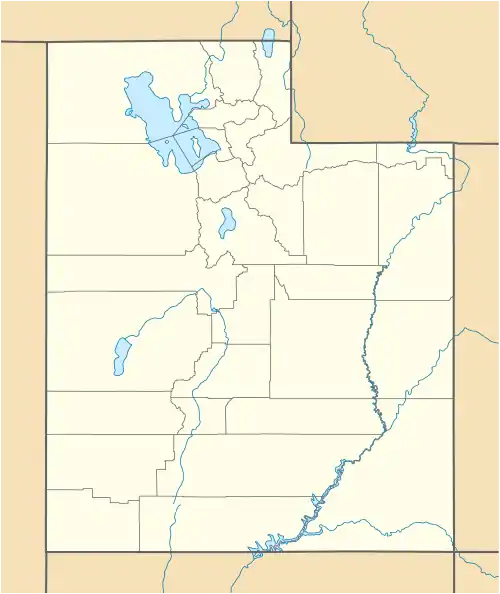Knolls | |
|---|---|
 Knolls Location of Knolls within the State of Utah  Knolls Knolls (the United States) | |
| Coordinates: 40°43′23″N 113°17′23″W / 40.72306°N 113.28972°W | |
| Country | United States |
| State | Utah |
| County | Tooele |
| Elevation | 4,229 ft (1,289 m) |
| Time zone | UTC-7 (Mountain (MST)) |
| • Summer (DST) | UTC-6 (MDT) |
| Area code | 435 |
| GNIS feature ID | 1437607[1] |
Knolls is an unincorporated community in north-central Tooele County, Utah, United States.[1]
Description
The community is located in Great Salt Lake Desert in the western portion of the state, close to the Utah Test and Training Range.[2] Exit 41 on Interstate 80 (I‑80) provides access to Knolls.
Prior to the building of I‑80, Knolls was serviced by U.S. Route 40 and was the eastern terminus of the Wendover Cut-off.
During the 1970s and up until 1985 (possibly longer) one family owned and operated the entire town, consisting of a towing service, a small convenience store, a gas station, and a small motel. There was no water on site, and water had to be trucked in by a small tank truck. The town was for sale for a relatively small amount in 1985. There is photo evidence of a small tavern at one time. There is little visible evidence that there was ever any town, buildings, or gas station left.
Knolls is located in a nearly uninhabited desert area, approximately 40 miles (64 km) east of the Bonneville Salt Flats and 80 miles (130 km) west of Salt Lake City. The landscape contains mud flats, salt flats, and gypsum sand dunes.[3] Much of the surrounding land is owned by the Bureau of Land Management and is maintained as an off highway vehicle park, known as the Knolls Recreation Area.[4]
Knolls is the site of one place listed on the National Register of Historic Places: the GAPA Launch Site, which is a concrete bunker and missile launch pad where the first Ground to Air Pilotless Aircraft missile was successfully tested in 1946.[5] The site is marked by a placard installed by the Utah State History division.
Knolls is also the site of a hazardous waste dump site known as Grassy Mountain.
Climate
The Great Salt Lake Desert experiences a desert climate with hot summers and cold winters. The desert is an excellent example of a cold desert climate, rare outside of North America. The desert's elevation, 4,250 feet (1,300 m) above sea level, makes temperatures cooler than lower elevation deserts, such as the Mojave. Due to the high elevation and aridity, temperatures drop sharply after sunset. Summer nights are comfortably cool. Winter highs are generally above freezing, and winter nights are bitterly cold, with temperatures often dropping close to zero.
| Climate data for Knolls, Great Salt Lake Desert, Utah. (Elevation 4,250ft) | |||||||||||||
|---|---|---|---|---|---|---|---|---|---|---|---|---|---|
| Month | Jan | Feb | Mar | Apr | May | Jun | Jul | Aug | Sep | Oct | Nov | Dec | Year |
| Record high °F (°C) | 63 (17) |
63 (17) |
79 (26) |
87 (31) |
98 (37) |
104 (40) |
106 (41) |
103 (39) |
99 (37) |
89 (32) |
71 (22) |
66 (19) |
106 (41) |
| Mean daily maximum °F (°C) | 36.5 (2.5) |
41.4 (5.2) |
54.4 (12.4) |
62.3 (16.8) |
72.3 (22.4) |
83.5 (28.6) |
92.8 (33.8) |
90.9 (32.7) |
80.0 (26.7) |
64.3 (17.9) |
46.5 (8.1) |
36.5 (2.5) |
63.4 (17.4) |
| Mean daily minimum °F (°C) | 16.9 (−8.4) |
19.3 (−7.1) |
29.1 (−1.6) |
36.6 (2.6) |
44.9 (7.2) |
54.7 (12.6) |
62.1 (16.7) |
59.5 (15.3) |
48.0 (8.9) |
34.4 (1.3) |
23.3 (−4.8) |
14.5 (−9.7) |
37.0 (2.8) |
| Record low °F (°C) | −16 (−27) |
−17 (−27) |
−1 (−18) |
14 (−10) |
24 (−4) |
35 (2) |
43 (6) |
39 (4) |
25 (−4) |
8 (−13) |
−3 (−19) |
−25 (−32) |
−25 (−32) |
| Average precipitation inches (mm) | 0.61 (15) |
0.46 (12) |
0.91 (23) |
1.01 (26) |
1.23 (31) |
0.68 (17) |
0.36 (9.1) |
0.31 (7.9) |
0.56 (14) |
0.77 (20) |
0.61 (15) |
0.38 (9.7) |
7.88 (200) |
| Average snowfall inches (cm) | 0.3 (0.76) |
0.1 (0.25) |
0 (0) |
0 (0) |
0 (0) |
0 (0) |
0 (0) |
0 (0) |
0 (0) |
0 (0) |
0 (0) |
0.1 (0.25) |
0.5 (1.3) |
| Source: The Western Regional Climate Center[7] | |||||||||||||
See also
References
- 1 2 "Knolls". Geographic Names Information System. United States Geological Survey, United States Department of the Interior.
- ↑ "MyTopo Maps - Knolls, UT, USA" (Map). mytopo.com. Trimble Navigation, Ltd. Retrieved March 10, 2018.
- ↑ Gypsum Sand near Knolls, Tooele County. Utah Geological Survey.
- ↑ Knolls Recreation Area, Bureau of Land Management.
- ↑ GAPA Launch Site, Center for Land Use Interpretation.
- ↑ Van Cott, John W. (1990). Utah Place Names: A Comprehensive Guide to the Origins of Geographic Names: A Compilation. Salt Lake City: University of Utah Press. p. 215. ISBN 978-0-87480-345-7. OCLC 797284427.
- ↑ "Seasonal Temperature and Precipitation Information". Western Regional Climate Center. Retrieved March 24, 2013.
External links
![]() Media related to Knolls, Utah at Wikimedia Commons
Media related to Knolls, Utah at Wikimedia Commons
